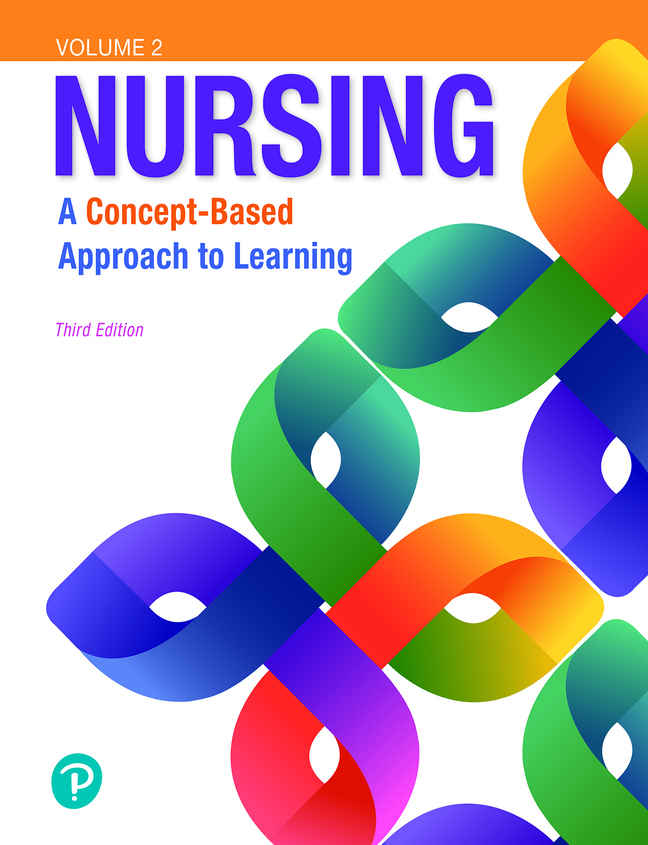
Nursing: A Concept-Based Approach to Learning, Volume 2, 3rd edition

- Study simpler and faster
Use flashcards and other study tools in your eTextbook
- Watch and learn
Videos & animations bring concepts to life
- Listen on the go
Learn how you like with full eTextbook audio
- Find it fast
Quickly navigate your eTextbook with search
- Stay organized
Access all your eTextbooks in one place
Nursing: A Concept-Based Approach to Learning is the only concepts curriculum built from the ground up as a comprehensive, cohesive learning system. This 3-volume series provides all the nursing curriculum content and materials needed to prepare you for nursing practice. With exemplars and assessment tools, you'll deepen your grasp of connections between concepts, with broad applications throughout a nursing career.
Volume II focuses on 30 psychosocial, reproductive, nursing and healthcare concepts, and then turns to the nurse's role in accountability, advocacy and safety. Exemplars illuminate concepts. The 3rd Edition is a full-scale revision bringing the text in line with new evidence-based practice, care and safety guidelines.
Published by Pearson (September 18th 2020) - Copyright © 2019
ISBN-13: 9780136873471
Subject: Concept-Based Nursing
Category:
Table of Contents
PART II: PSYCHOSOCIAL MODULES
- Module 22: Addiction
- The Concept of Addiction
- 22.A Alcohol Abuse
- 22.B Nicotine Use
- 22.C Substance Abuse
- Module 23: Cognition
- The Concept of Cognition
- 23.A Alzheimer Disease
- 23.B Delirium
- 23.C Schizophrenia
- Module 24: Culture and Diversity
- The Concept of Culture and Diversity
- Module 25: Development
- The Concept of Development
- 25.A Attention-Deficit/Hyperactivity Disorder
- 25.B Autism Spectrum Disorder
- 25.C Cerebral Palsy
- 25.D Failure to Thrive
- Module 26: Family
- The Concept of Family
- 26.A Family Response to Health Alterations
- Module 27: Grief and Loss
- The Concept of Grief and Loss
- Module 28: Mood and Affect
- The Concept of Mood and Affect
- 28.A Depression
- 28.B Bipolar Disorders
- 28.C Postpartum Depression
- 28.D Suicide
- Module 29: Self
- The Concept of Self
- 29.A Feeding and Eating Disorders
- 29.B Personality Disorders
- Module 30: Spirituality
- The Concept of Spirituality
- 30.A Spiritual Distress
- 30.B Religion
- Module 31: Stress and Coping
- The Concept of Stress and Coping
- 31.A Anxiety Disorders
- 31.B Crisis
- 31.C Obsessive-Compulsive Disorder
- Module 32: Trauma
- The Concept of Trauma
- 32.A Abuse
- 32.B Multisystem Trauma
- 32.C Posttraumatic Stress Disorder
- 32.D Rape and Rape-Trauma Syndrome
PART III: REPRODUCTION MODULE
- Module 33: Reproduction
- The Concept of Reproduction
- 33.A Antepartum Care
- 33.B Intrapartum Care
- 33.C Postpartum Care
- 33.D Newborn Care
- 33.E Prematurity
PART IV: NURSING DOMAIN
- Module 34: Assessment
- The Concept of Assessment
- Module 35: Caring Interventions
- The Concept of Caring Interventions
- Module 36: Clinical Decision Making
- The Concept of Clinical Decision Making
- 36.A The Nursing Process
- 36.B The Nursing Plan of Care
- 36.C Prioritizing Care
- Module 37: Collaboration
- The Concept of Collaboration
- Module 38: Communication
- The Concept of Communication
- 38.A Groups and Group Communication
- 38.B Therapeutic Communication
- 38.C Documentation
- 38.D Reporting
- Module 39: Managing Care
- The Concept of Managing Care
- 39.A Case Management
- 39.B Cost-Effective Care
- 39.C Delegation
- 39.D Leadership and Management
- Module 40: Professionalism
- The Concept of Professionalism
- 40.A Commitment to Profession
- 40.B Work Ethic
- Module 41: Teaching and Learning
- The Concept of Teaching and Learning
- 41.A Patient/Consumer Education
PART V: HEALTHCARE DOMAIN
- Module 42: Accountability
- The Concept of Accountability
- 42.A Competence
- 42.B Professional Development
- Module 43: Advocacy
- The Concept of Advocacy
- 43.A Environmental Quality
- Module 44: Ethics
- The Concept of Ethics
- 44.A Morality
- 44.B Ethical Dilemmas
- 44.C Patient Rights
- Module 45: Evidence-Based Practice
- The Concept of Evidence-Based Practice
- Module 46: Healthcare Systems
- The Concept of Healthcare Systems
- 46.A Emergency Preparedness
- Module 47: Health Policy
- The Concept of Health Policy
- Module 48: Informatics
- The Concept of Informatics
- 48.A Clinical Decision Support Systems
- 48.B Individual Information at Point of Care
- Module 49: Legal Issues
- The Concept of Legal Issues
- 49.A Nurse Practice Acts
- 49.B Advance Directives
- 49.C Health Insurance Portability and Accountability Act
- 49.D Mandatory Reporting
- 49.E Risk Management
- Module 50: Quality Improvement
- The Concept of Quality Improvement
- Module 51: Safety
- The Concept of Safety
- 51.A Health Promotion and Injury Prevention Across the Lifespan
- 51.B Patient Safety
- 51.C Nurse Safety